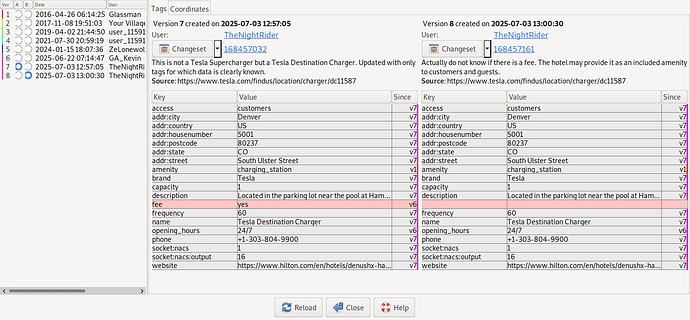Dang @TheNightRider you’ve been busy!! Solid work!
I have no issue if you want to go through and add something like ref:supercharge_info:source and have it be the whole URL, I just ask that we keep ref:supercharge_info as the ID as we are doing analysis and updates with that value and that corresponds directly to the ID in the Supercharge.info database. So it is useful for more than just a nice link to have the ID separate 
RE: Brand vs Name
Most every EV charger does not have a name, and very, very few stations in the US do. Every Supercharger in the US displays the brand which is Tesla, not the name which Tesla gives them, Superchargers. Superchargers are nothing special, it just means it’s a EV charging station, DC power provided, and branded Tesla. That’s also why we recently voted unanimously to deprecate Tesla socket tags, since there is no difference between the marketing term and the actual connector name.
EVgo (your first image) is likely the one wide-scale exception here. They name their dispensers cutesy human-like names which should probably use name=*. I couldn’t quite make it out on your photo but the name would be on that black colored label on the top of the screen I believe (as well as in their app.)
Please don’t tag for the renderer, we have Issues in with Carto to get the brand displayed but OSM data should lead renderers not renderers lead OSM data! And Carto is not the only renderer out there! Heck, it’s not even my favorite!
Yes, working on the write up for the cleanup on this. I have an Overpass query with these adjacent nodes with ref:supercharge_info and stations without (ways). Will likely pick that up after the US holiday this weekend.
This was not in scope for this effort. Though it’s interesting that the hotel one you found was without a ref:supercharge_info or tags like website that were part of the import. It probably just caught tags like frequency and motorcar if I had to guess. Thanks for updating this one and for going above and beyond by calling the hotel!! Truly admirable work there!!
I agree, this is actually a much larger issue in the US than just Tesla, so many EV dispensers are tagged as charging stations, akin to tagging every gas pump as a gas station. You can substitute the relation ID in this Overpass query to find these ugly ducklings, this one is for Massachusetts since SOTM US was there last month and I wanted to show the issue:
rel(61315);map_to_area->.state;
nwr[amenity=charging_station](area.state)->.allStations;
foreach.allStations->.station(
nwr(around.station:100)(if:t["operator"]==station.u(t["operator"])||t["name"]==station.u(t["name"])||t["brand"]==station.u(t["brand"]))
[amenity=charging_station]->.new;
((.new; - .station;);.adjacent;)->.adjacent;);
.adjacent out;
Also regarding general cleanup of EVs in the US with both SC.info and AFDC, Ive created a MapRoulette challenge to ask people to double check things:



















